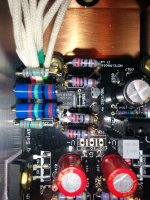Scorpion's DIY dual-mono power amp
Hi Jay,
Ok, so here are a few pics of my dual-mono amp. I built it some 10 years ago and kept fine-tuning it in order to improve the sound over and over during all these years.
After asking again and again, the guy who made the boards, I finally learned that it is based on a Leach amp (still not completely a Leach according to him).
I personally decided to bypass the relays and use a ''ON-ON'' switch with a power resistor on the ''standby mode'' (so to speak). This was done to limit the initial surge when first firing up the amp with empty lytics. This, sets it even further apart from the Leach.
Then, I turn the amp ''full ON'' wich bypasses the power resistors and give full voltage. I DON'T KNOW...I AM NOT A TECH GUY SO I DON'T KNOW HOW TO EXPLAIN THE PROCESS IN DETAILS OR PRECISELY. Sorry for that.
Each channel has 1KVa Plitron LONO transformers, 156 000uF Beyschlag lytics, 2 IXYS Soft Recovery bridges (for B+, B-), it's own board, power switch, power cord etc.
Btw, what would be the output power at 8 and 4 ohms considering the above specs and the fact that I run at about 65volts on the rails (lytics) and have only 4 power transistors per channel ??? I was supposed to install an ''add-on'' board with more power transistors but never did.
Anyway, it sounds very good. Refined and musical.
Regards
Scorpion
Hi Jay,
Ok, so here are a few pics of my dual-mono amp. I built it some 10 years ago and kept fine-tuning it in order to improve the sound over and over during all these years.
After asking again and again, the guy who made the boards, I finally learned that it is based on a Leach amp (still not completely a Leach according to him).
I personally decided to bypass the relays and use a ''ON-ON'' switch with a power resistor on the ''standby mode'' (so to speak). This was done to limit the initial surge when first firing up the amp with empty lytics. This, sets it even further apart from the Leach.
Then, I turn the amp ''full ON'' wich bypasses the power resistors and give full voltage. I DON'T KNOW...I AM NOT A TECH GUY SO I DON'T KNOW HOW TO EXPLAIN THE PROCESS IN DETAILS OR PRECISELY. Sorry for that.
Each channel has 1KVa Plitron LONO transformers, 156 000uF Beyschlag lytics, 2 IXYS Soft Recovery bridges (for B+, B-), it's own board, power switch, power cord etc.
Btw, what would be the output power at 8 and 4 ohms considering the above specs and the fact that I run at about 65volts on the rails (lytics) and have only 4 power transistors per channel ??? I was supposed to install an ''add-on'' board with more power transistors but never did.
Anyway, it sounds very good. Refined and musical.
Regards
Scorpion
Attachments
-
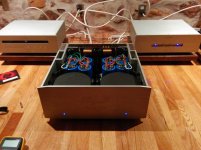 Top view 1.jpg645.3 KB · Views: 554
Top view 1.jpg645.3 KB · Views: 554 -
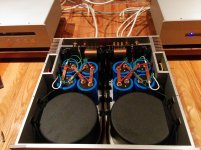 Top view close-up.jpg687.7 KB · Views: 540
Top view close-up.jpg687.7 KB · Views: 540 -
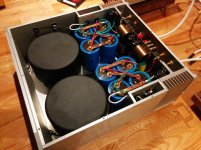 Top view side.jpg788.1 KB · Views: 545
Top view side.jpg788.1 KB · Views: 545 -
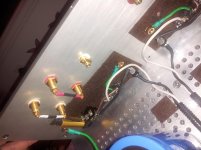 Amp AC.jpg716 KB · Views: 500
Amp AC.jpg716 KB · Views: 500 -
 Amp front view.jpg729.3 KB · Views: 458
Amp front view.jpg729.3 KB · Views: 458 -
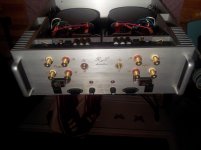 Amp rear view.jpg577.6 KB · Views: 241
Amp rear view.jpg577.6 KB · Views: 241 -
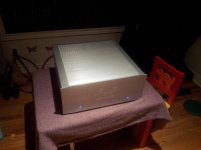 Amp top cover.jpg543.3 KB · Views: 235
Amp top cover.jpg543.3 KB · Views: 235 -
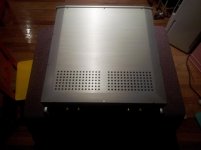 Amp top view-cover.jpg514.7 KB · Views: 177
Amp top view-cover.jpg514.7 KB · Views: 177
Jameshillj,
Those MSR860s by OnSemi seem interesting. I might give them a try when it'll be ''bridge rectifier tryouts'' time...
Thanks for the tips
Regards
Scorpion
They are listed for the Reflektor-D shunt reg and the FSP raw DC board too. In the MSRF860 full plastic encapsulated version. Because we don't need the best RthJC spec there. There are no sinks at all at those currents anyway. Good diode parts, never roughening the mix.
Are you machining metal in custom design at some local shop for your boxes btw?
Hi Salas,
I invented and drew everything. Came out of what brain I had left !!! ;-) I machined most of it. Back then, I had access to machinery and some teachers (friends) from an Aerospace school in Montreal. Some of the work was done there (like the angulated top plate and faceplate). The rest, I pretty much did myself.
Of course, anodizing and engraving were done by special shops.
Oh and btw Salas, could you please answer the question above about my amp's probable power output @ 8 and 4 ohms ?
Thanks
Regards
Scorpion
Btw, what would be the output power at 8 and 4 ohms considering the above specs and the fact that I run at about 65volts on the rails (lytics) and have only 4 power transistors per channel ??? I was supposed to install an ''add-on'' board with more power transistors but never did.
Anyway, it sounds very good. Refined and musical.
The Leach amp is very good. Tho it was not my "taste".
Original Leach amp (Low TIM) uses 58V, 4 transistors per channel as well and 120W/8R output (higher with lower load).
Nobody knows the wattage of your amp without seeing the circuit. With similar setup as the original it could be 150W but I guess close to 200W with change in gain and bias. Many had modified the circuit for bigger wattage (including the official super leach which I think was 270W).
Oh and btw Salas, could you please answer the question above about my amp's probable power output @ 8 and 4 ohms ?
Thanks
Regards
Scorpion
As Jay wrote about probable power. To find out for sure, it takes a big dummy load, a gen, and a scope.
About the boxes, congrats. Developing several big chassis from scratch takes dedication and time.
About the boxes, congrats.
I think it is the most impressive I have seen, especially the back and the top. But I have never seen dual AC outlet before. Is this common with some commercial amp? I can't imagine it has benefit.
I think it is the most impressive I have seen, especially the back and the top. But I have never seen dual AC outlet before. Is this common with some commercial amp? I can't imagine it has benefit.
Jay,
Think of two identical monoblocks (each with their own AC outlet, of course)...in one chassis.
Each mono doesn't have to "share" voltage fron the wall outlet. Each have their own power cord and dedicated line in the wall and a separated breaker panel.
In fact, all my gears have their own separated line. Makes a big difference (lower noise, much darker background, more air, better separation, image stability and transients).
A few companies do it that way. Gryphon Audio being one of them if memory serves me well.
Regards
Scorpion
Last edited:
As Jay wrote about probable power. To find out for sure, it takes a big dummy load, a gen, and a scope.
About the boxes, congrats. Developing several big chassis from scratch takes dedication and time.
Thanks Salas. Yep, a lot of passion and dedication. ..way too much for the WAF !!!
Well, we all know about that ! ;-)
Regards
Scorpion
A dual mono with separated mains wiring still ends up with a commoned Chassis for the PE connection.
One still has to design the wiring as for a dual mono amplifier.
The two Chassis of a pair of monoblocks MUST be electrically isolated from each other to achieve monoblock channel isolation.
One still has to design the wiring as for a dual mono amplifier.
The two Chassis of a pair of monoblocks MUST be electrically isolated from each other to achieve monoblock channel isolation.
A dual mono with separated mains wiring still ends up with a commoned Chassis for the PE connection.
One still has to design the wiring as for a dual mono amplifier.
The two Chassis of a pair of monoblocks MUST be electrically isolated from each other to achieve monoblock channel isolation.
Hi AndrewT,
What is a PE connection?
And, I am not sure I understood you correctly, do you mean my amp is not a dual mono and would be some sort of a hybrid between real monoblocks and a dual-mono (maybe because they share common grounding in the same chassis) ?
Sorry for asking. You know damn well how limited my tech knowledge is. You and Salas are my "techies references" .
Thanks a lot AndrewT.
Btw, would 150watts or so @ 8ohms be a realistic average power output for my amp (according to above stated specs)? The bias is set at around 25 milli.
Regards
Scorpion
The PE connection is what helps stop you killing yourself and your friends who touch your amplifier.
The Mains third wire is the Protective Earth.
Before you build any Mains powered project you should already know that !
The Mains third wire is the Protective Earth.
Before you build any Mains powered project you should already know that !
The PE connection is what helps stop you killing yourself and your friends who touch your amplifier.
The Mains third wire is the Protective Earth.
Before you build any Mains powered project you should already know that !
Thanks.
Well, I guess I knew it (in french)... but not the term PE in english. That's all. Since nobody got killed, I guess some things were done right.
Regards
Scorpion
Last edited:
Heck, I didn't know what it was either. (PE)
Us Yanks call it Ground.
Hi Renron,
Same for us Canucks. Ground is the word.
Why AndrewT keeps such a tone towards many fellow DIYers, myself included, is beyond me.
Anyway, back to the purpose of this thread: resistors tryouts. I will post more results tonight. I am a little late on them.
Regards
Scorpion
Calling it just *ground* can be a problem. The Audio Circuit also has Ground. Does that mean it is the same ground as chassis ground?
Wrong E, that's called signal ground. And yep, they certainly are different. That's just Andrew being Andrew, it's not personal. He has learned more in his first year of electronics than I will in my lifetime !
Calling it just *ground* can be a problem. The Audio Circuit also has Ground. Does that mean it is the same ground as chassis ground?
Hi BigE,
Those 4 wheeled stuff we see on the road are all called vehicles. Still, I can differentiate a sedan from a pickup...just as I can between chassis and circuit grounds when they are not called PE.
It was just a term thing.
Case close.
Regards
Scorpion
Last edited:
220R Shinkoh Tantalum-1Mega Riken Ohms-220K Takman REY metal film
Ok, here is the sound of Takman metal film @ 1/2 watt.
This metal film resistor is clean, precise and with very good focus. The transparency is average so the amount of air between instruments is somewhat limited. Same goes for harmonics. That was especially noticeable on good puano recordings. Articulation is average and so are transients. Voices have a rear-hall presentation and are not really full. They seemed detached from the rest of the music. Just not the real thing.
Bass is tight and controlled but doesn't go real deep. Especially compared to the Dralorics' wich was thunderous. The soundstage has good width and depth but is not really layered. Just big.
The overall presentation is a bit forward. Timbres are a little cold and have a "nasality" that make the sound artificial and metallic. But what really stroke me was how I got a "congested sound" on demanding tracks (especially on classic and orchestral music). The Takman seemed to loose its footing, like if it didn't know what to do with all this information. The sound became congested, confused and saturated. Bad bad coherence. No sensuality. No musicality. No "soul" at all.
It was the first resistor to behave like that.
While I was listenning (late at night after thekids went to bed) my wife asked me wheter I wanted a herbal tea since she was doing some. She told me :"Do your things, no pressure. I am going to bed and will read a little". Well, she came back a few minutes later with my cup and while still in the stairs (listening room is in the basement) she complained about how bad it sounded. When I told her I had change a resistor, she said it was artificial, fatiguing and metallic sounding. And added: " Make sure to get rid of it and never put it in our stuff" !!!!! I am dead serious !!!
Yep, what a bad fit !
Regards
Scorpion
Ok, here is the sound of Takman metal film @ 1/2 watt.
This metal film resistor is clean, precise and with very good focus. The transparency is average so the amount of air between instruments is somewhat limited. Same goes for harmonics. That was especially noticeable on good puano recordings. Articulation is average and so are transients. Voices have a rear-hall presentation and are not really full. They seemed detached from the rest of the music. Just not the real thing.
Bass is tight and controlled but doesn't go real deep. Especially compared to the Dralorics' wich was thunderous. The soundstage has good width and depth but is not really layered. Just big.
The overall presentation is a bit forward. Timbres are a little cold and have a "nasality" that make the sound artificial and metallic. But what really stroke me was how I got a "congested sound" on demanding tracks (especially on classic and orchestral music). The Takman seemed to loose its footing, like if it didn't know what to do with all this information. The sound became congested, confused and saturated. Bad bad coherence. No sensuality. No musicality. No "soul" at all.
It was the first resistor to behave like that.
While I was listenning (late at night after thekids went to bed) my wife asked me wheter I wanted a herbal tea since she was doing some. She told me :"Do your things, no pressure. I am going to bed and will read a little". Well, she came back a few minutes later with my cup and while still in the stairs (listening room is in the basement) she complained about how bad it sounded. When I told her I had change a resistor, she said it was artificial, fatiguing and metallic sounding. And added: " Make sure to get rid of it and never put it in our stuff" !!!!! I am dead serious !!!
Yep, what a bad fit !
Regards
Scorpion
- Status
- Not open for further replies.
- Home
- Source & Line
- Analog Line Level
- Salas hotrodded DCB1 resistor tryouts
